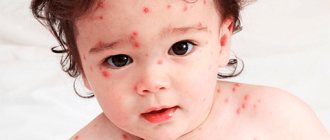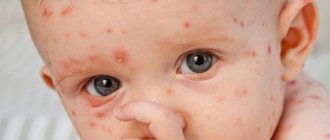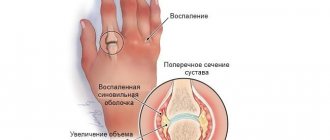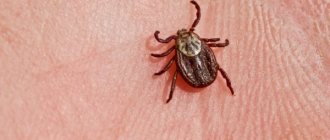Measles has been known since ancient times: the symptoms of this disease were first described in the 9th century by the Arab physician Rhazes. In Russia, the first mention of measles dates back to 1744.
Official registration of cases of measles began only in the middle of the 19th century, and then it was considered primarily a childhood infection with a high mortality rate. Currently, adults are increasingly becoming infected with it; photographs of people with measles presented below give an idea of the visual manifestations of this disease.
Roseola.
This is a herpes infection, the main symptom of which is high fever, which lasts about three days in the absence of other symptoms of ARVI. Then the temperature drops, the condition improves, and a rash appears.
An important difference from measles is that with measles, symptoms do not improve with the appearance of a rash.
With roseola, the rash first appears on the torso and then spreads to the neck and upper and lower extremities.
How does measles develop (pathogenesis of the disease)
The entry point for measles viruses is the mucous membrane of the oral cavity, pharynx, upper respiratory tract and conjunctival membrane of the eyes. First of all, viruses infect immune cells - macrophages, reticular and lymphoid cells. An increase in the number of lymphomacrophage elements leads to tissue proliferation and the formation of focal infiltrates. Actively multiplying, the viruses begin to penetrate regional lymph nodes and blood. The incubation period for measles ranges from 8 to 13 days.
Rice. 2. The photo shows measles in children. On the first day of the rash, the rash is localized on the face.
Viremia in measles
Viremia (entry of pathogens into the bloodstream) develops 3–5 days from the beginning of the incubation period. It reaches its maximum at the end of the incubation period and at the beginning of the rash period. During this time, viruses are fixed in the cells of the reticuloendothelial system. The work of immune mechanisms is launched, which leads to a massive release of pathogens. A second wave of viremia develops. Viruses reinfect cells in the mucous membranes of the mouth, pharynx and upper respiratory tract. When the virus is introduced into the central nervous system, measles encephalitis develops. The skin is affected. In some leukocytes, chromosomes are damaged, and the epithelium of the respiratory tract becomes necrotic.
Measles viruses cause hyperplasia of lymphoid tissue. In the adenoids and tonsils, lymph nodes and spleen, appendix and skin, in lung tissue and sputum, giant multinucleated Warthin-Finkeldey cells appear. Detection of these cells is a pathognomonic sign of measles.
On the third day of the rash, the number of viruses in the blood decreases, and on the 4th day their blood disappears completely. Virus-neutralizing antibodies appear in the blood.
Rice. 3. The photo shows giant multinucleated Warthin-Finkelday cells.
Origin of measles rash
Allergic reactions develop to the protein components of pathogens in the patient’s body. The permeability of small vessels increases, their walls are damaged. In organs and tissues (usually the respiratory and digestive systems) in the mucous membranes, catarrhal-necrotic inflammation develops. The upper layers of the skin are affected, on which a papular rash first appears. Subsequently, the epidermal cells undergo necrosis, which is manifested by peeling.
In the oral cavity, the epithelium also undergoes necrotization. It becomes cloudy. Foci of necrosis become similar to small white dots (Belsky-Filatov-Koplik spots). They appear a day before skin rashes. The skin rash appears in stages, starting from the head and then gradually spreading to the entire body.
Rice. 4. In the photo, the symptoms of measles are Belsky-Filatov-Koplik spots.
Development of complications
Measles viruses in the patient’s body suppress both general and local immunity. Under their influence, the number of T-lymphocytes decreases. Anergy develops. Chronic diseases are getting worse. The addition of a secondary infection causes the development of catarrhal-necrotic inflammation in the upper respiratory tract, digestive system and skin.
Infectious mononucleosis.
With mononucleosis, rashes appear in approximately 10% of patients. Moreover, the rash immediately covers the entire body (with measles, remember, it spreads from top to bottom).
If a patient with mononucleosis received a penicillin antibiotic (this is a medical error, alas, not uncommon in our area), the likelihood of a rash increases to 90%. This rash is called ampicillin and indicates an allergy to the antibiotic.
Complications (consequences) of measles
The cause of measles complications is the effect of the virus on the patient’s immune system. In the peripheral blood, the number of T-lymphocytes sharply decreases. Allergization of the body to the protein components of viruses contributes to the development of inflammation, which leads to increased permeability of small vessels and damage to their walls. In the mucous membranes of organs and tissues (usually the respiratory and digestive systems), catarrhal-necrotic inflammation develops.
- The layering of a secondary (viral-bacterial) infection leads to the development of a number of purulent-necrotic inflammatory processes in the nose, larynx, trachea, bronchi and lung tissue.
- Stomatitis and colitis develop.
- With the disease, conjunctivitis always develops. The cornea of the eye is often affected.
- During the period of pigmentation, inflammation of the middle ear often occurs.
- Under unfavorable sanitary and hygienic conditions, pustular lesions of the skin caused by streptococci and staphylococci develop.
- Microcirculation disorders in the brain lead to hypoxia and encephalopathy develops. Measles encephalopathy is more often recorded in young children. More severe complications of measles are encephalitis and meningoencephalitis. Pathology develops on days 5–7 of the disease. The course of the disease is severe, with a high mortality rate (up to 10%). Surviving children (about 40%) often have mental disorders and epilepsy.
- Damage to the optic and auditory nerves always results in serious consequences. Damage to the spinal cord leads to pelvic disorders.
- Very rarely, myocarditis, hepatitis and glomerulonephritis develop as a result of measles infection.
Rice. 12. The photo shows measles in children. The addition of a secondary infection leads to the development of bacterial conjunctivitis. The conjunctiva of the eyes becomes hyperemic, the eyelids swell, and purulent discharge appears from the eyes.
Measles in adults
Measles in adults and adolescents is often severe. The intoxication syndrome is significantly expressed. Patients often experience severe headaches and vomiting. Sleep is disturbed. The catarrhal period lasts 4 - 8 days. Catarrhal symptoms of the upper respiratory tract are weakly expressed, Belsky-Filatov-Koplik spots are abundant, often persisting throughout the entire period of the rash. The rash is profuse. Several groups of lymph nodes are enlarged. Sometimes an enlarged spleen is palpable. Complications rarely develop.
Rice. 14. The photo shows measles in adults. A rash is the main symptom of the disease.
Incubation period
This is the time period that begins at the moment of infection and continues until the first signs of the disease appear. It is generally accepted that this period in children is 7-14 days. At this stage, the virus multiplies “quietly” in the body, there are no symptoms of measles, and the child is not bothered by anything at all. In this case, the baby becomes infectious to others only in the last 5 days of the incubation period.
For prevention in preschool institutions, it is necessary to limit children with measles symptoms to 5 days after the first rash appears.
Causes
Measles is caused by a viral infection and is highly contagious. It is estimated that about 90 percent of unvaccinated people close to those in the contagious phase of measles will also become infected.
Measles is spread in a similar way to colds and flu, that is, by inhaling airborne droplets that an infected person coughs or sneezes on. Although physical contact, coughing and sneezing are the most common ways to spread the infection, you can also get measles simply by breathing contaminated air or touching a contaminated surface and then inhaling droplets.
The measles virus can live for up to two hours on surfaces and in the air.
Diagnostics
Diagnosis of measles, which occurs without complications and with a typical picture - ARVI symptoms and a characteristic rash, is simple and is based on examination of the sick child.
To identify atypical forms and when the temperature rises again, signaling the addition of a bacterial infection, laboratory tests and instrumental studies are prescribed:
- general blood test, study of its coagulability;
- serological tests using ELISA and PCR methods;
- collection of cerebrospinal fluid;
- smears of bronchial discharge (RIF study).
Instrumental methods usually include chest x-ray and echocardiography.
Despite the ease of recognizing measles, when making a diagnosis, doctors have to exclude other diseases that may have a similar symptomatic picture.
Differential diagnosis is carried out to exclude rubella and scarlet fever. IMN, an infectious mononucleosis that is sometimes confused with tonsillitis and antibiotics are prescribed for its treatment, can also misdirect the doctor. One of them, ampicillin, can cause a rash very similar to measles.
Prevention
Measles is an acute viral disease that is one of the most contagious and common infections. The causative agent of measles is an RNA virus of the morbillivirus genus, which is transmitted by airborne droplets. This virus has very low resistance to various influences (boiling, disinfection) and dies quite quickly outside the human body.
Although we are accustomed to thinking of measles as a common childhood disease, it is very dangerous. Every hour around the world, 15 people die from it, which amounts to 165,000 people a year.
And before 1980, the number of deaths was 20 times greater! Mortality rates are particularly high in developing countries in Africa and Asia. There, 20% of child deaths are associated with measles. We managed to get rid of major measles epidemics thanks to universal vaccination.
Children aged 1 and 6 years are vaccinated against measles, rubella and mumps. Even if vaccinated people get sick, they experience a mild form of the disease.
In this article we will look at measles in adults; detailed photographs of the disease will help us with this, as well as the first symptoms and current methods of treating measles; in addition, we will not forget to mention preventive measures, they will help avoid the disease and its dangerous complications.
How can you get infected?
Measles infection occurs through airborne droplets. The contagiousness index is 95%, that is, it is a highly contagious disease. To transmit the infection, direct contact with the patient is necessary; transmission of the virus practically does not occur through common things and third parties.
Cases of the disease are recorded all year round, but more often during the cold season. Children aged 4 and 5 years are most often affected. Babies under one year old who have received antibodies against the virus from their mother are immune in the first 4 months of life. In the future, the immune system weakens, and the child may become infected upon contact with a sick person. The patient remains infectious until the fifth day from the onset of the rash, and with complications until the tenth day.
The only bright spot in all this is the very powerful lifelong immunity after illness.
Atypical course of measles
There is a typical and atypical course of measles. The typical clinical picture was described above. An atypical course is as follows:
1. Erased (mitigated) form of measles. It occurs in a very mild form and occurs with the administration of gamma globulin or immediately after vaccination against measles.
2. Hemorrhagic form - accompanied by multiple hemorrhages, bloody stool and urine. The patient often dies from bleeding. With timely hospitalization and intensive care, the outcome can be conditionally favorable.
3. Hypertoxic. Observed with increased intoxication. The patient may have a very high, persistent temperature, signs of meningoencephalitis, heart failure and other symptoms. This form requires immediate hospitalization.
Complications most often occur in adults with reduced immunity and in the elderly.
Treatment of measles in adults
Let’s make a reservation right away: a specific treatment that would fight the measles virus simply does not exist in nature. Therefore, treatment of measles in adults is symptomatic - it involves preventing the development of complications, alleviating the patient's condition - that is, the doctor focuses on the symptoms and fights them.
Experts advise not to take risks, monitor your health, develop immunity, get vaccinated on time, and if you get sick, immediately contact a specialist for help and under no circumstances self-medicate.
Undoubtedly, the most important method of prevention is vaccination. Vaccination of adults against measles is necessary, but it is better if the vaccination is given in childhood - at 1 year and at 6 years. But if this procedure is not carried out on time, there is no reason to be upset. Measles vaccination in adults is also carried out in two stages with a break of three months.
The most common complications of measles vaccination in adults are:
• temperature rise for 5-15 days (sometimes up to 40 degrees), which lasts up to four days. It can be brought down with antipyretic drugs, for example, paracetamol.
• in addition to fever, rhinitis, cough, and a small rash may also bother you.
Atypical forms of measles
In addition to the typical course, the disease may have an atypical course.
Atypical (erased) form
An atypical form of measles is observed in children 3–9 months old, since during this period the disease develops against the background of passive immunity, which they receive at birth from their mother. The incubation period for the atypical course is extended, there are no typical signs of the disease, the course is blurred, and the phasing of the rash is disrupted.
Measles in vaccinated children
If for some reason a vaccinated child does not have antibodies against the disease, then when infected with measles viruses, the disease will proceed normally. If a small amount of antibodies remains in the child’s body, then measles will occur in an erased form.
Mitigated measles
Mitigated measles develops when a measles vaccine or immunoglobulin is administered to a person infected with measles viruses during the incubation period. A situation arises when an infected person has acquired immunity to the disease, but its level is insufficient. The developed disease occurs in a mild form.
- The incubation period for mitigated measles is extended and ranges from 21 to 28 days.
- The catarrhal period is short and ends after 1 - 2 days, or is completely absent.
- Symptoms of the disease are mild.
- Body temperature is often absent or rises to low-grade levels. There are no Belsky-Filatov-Koplik spots on the buccal mucosa.
- The rash on the skin is scanty, not abundant, pale in color. It appears simultaneously on all areas of the skin and is often absent on the extremities. Not inclined to merge. The pigmentation of the rash is weak and disappears quickly.
- The disease proceeds without complications.
- Diagnosis of the disease is often difficult. The basis of laboratory diagnosis is serological testing.
"Black" or hemorrhagic measles
In severe cases of the disease, the rash may become hemorrhagic. Numerous hemorrhages and even hemorrhages appear on the skin, the diameter of which exceeds 3 mm (echimosis, in everyday life - bruises). Hemorrhages also appear on the mucous membrane of the eyes and mouth.
Congestive (dyspnoic) form of measles
The congestive or dyspnoic form of the disease is manifested by severe shortness of breath and continuous cough, with scanty physical data. The rash appears late and has a cyanotic tint. Hypoxia gradually increases. Lack of blood circulation in the brain leads to seizures and loss of consciousness. The cause of the congestive or dyspnoic form of measles is considered to be damage to lung tissue by viruses (pulmonary measles).
Reaction to vaccination
When administered a live measles vaccine, 25–50% of children develop a severe reaction resembling mitigated measles. This reaction occurs with elevated body temperature, catarrh of the upper respiratory tract and scant rash. Convulsions and vomiting are rarely observed.
Vaccinated individuals do not pose a danger to others. Children with immunodeficiencies are not allowed to receive vaccinations. The introduction of a live vaccine causes a severe reaction in them.
Course of measles in persons with immunodeficiency
In 80% of cases in people with immunodeficiency, the disease is extremely severe. In 70% of cases in cancer patients and in 40% of cases in HIV-infected people, measles is fatal. In a third of patients with immunodeficiency, there is no rash due to measles; in 60% of cases, the rash is atypical. The complications are severe.
Rice. 13. Figure 22 and 23. The photo shows measles in children. In the photo on the left there is a rash on the face (day 1 of the rash), in the photo on the right there is a rash on the face and torso (day 2 of the rash).
Prevention
Since measles is especially difficult for people to tolerate in adulthood, if the vaccine was not given in childhood, it is worth thinking about it now. First of all, this will significantly reduce the risk of catching this unpleasant disease, and even if a person gets sick, the symptoms and course of the disease will be significantly milder. The chance of serious complications also decreases significantly. The use of a special vaccine allows the body to artificially develop immunity against measles for approximately ten, and sometimes twenty years. This procedure is especially relevant for employees of preschool and school institutions and hospitals. There are certain contraindications for which this vaccination is not carried out:
- During pregnancy and lactation, vaccinations with live microorganisms are prohibited;
- recent blood transfusion;
- treatment with drugs that reduce immunity;
- carrying out routine or emergency immunizations.
Most often, patients are advised to use the MMR combination vaccine, which works against measles, rubella and mumps. The first vaccination is usually done in preschool age; there is a special, strictly regulated schedule. When planning a pregnancy, you should be very careful; vaccination can be carried out no later than one month before the planned date of conception.
Measles vaccination is recommended for all people without exception and helps reduce the number of diseases
Some patients may develop various complications after vaccination. Most often, high fever, cough, small rashes, and runny nose appear.
When treating a patient at home, close people need to limit communication with him, wear special protective masks and ventilate the premises daily. It is best to place the patient in a separate room and be sure to provide him with personal dishes, a towel and toiletries. Remember that any contact with people can lead to infection.
Treatment
Roseola infantile
Doctors do not have a specific treatment for roseola. They recommend rest and drinking plenty of fluids, as well as pain relievers such as acetaminophen or anti-inflammatory drugs such as ibuprofen.
Measles
As with roseola, there is no specific treatment for measles. You can use pain relievers and anti-inflammatory medications to control your fever and drink plenty of fluids to prevent dehydration.
The World Health Organization (WHO) recommends daily doses of vitamin A for 2 days for those who are malnourished or immunocompromised.
Measles is a preventable disease because there is a safe and effective vaccine.










